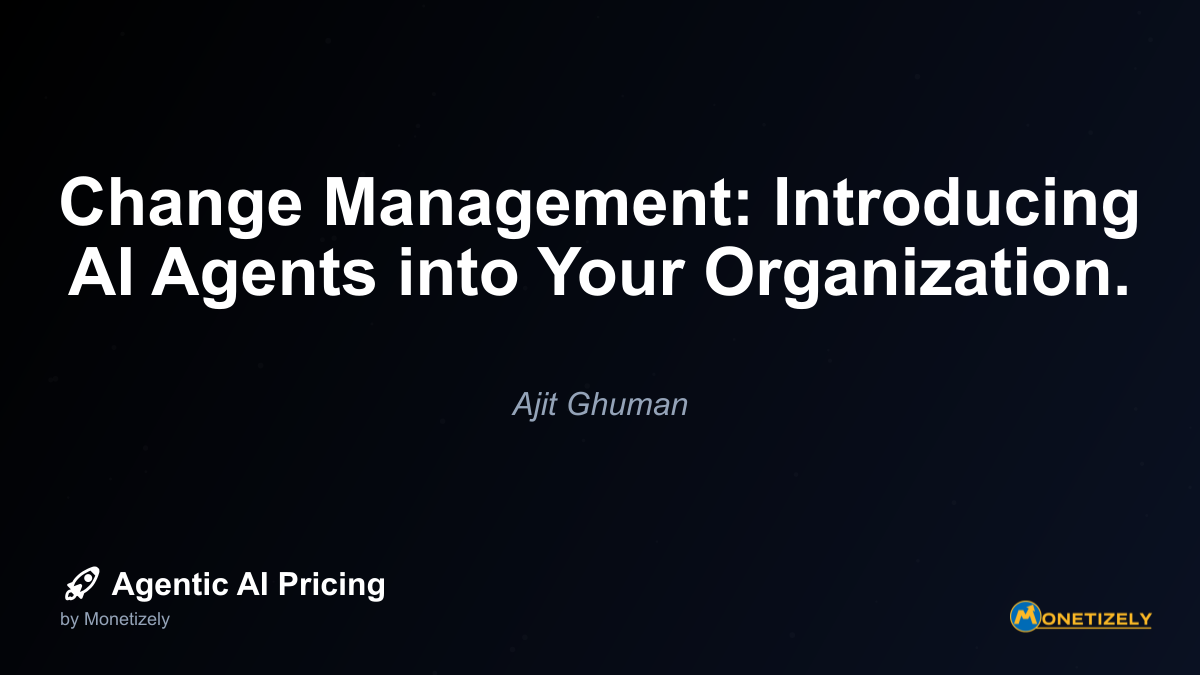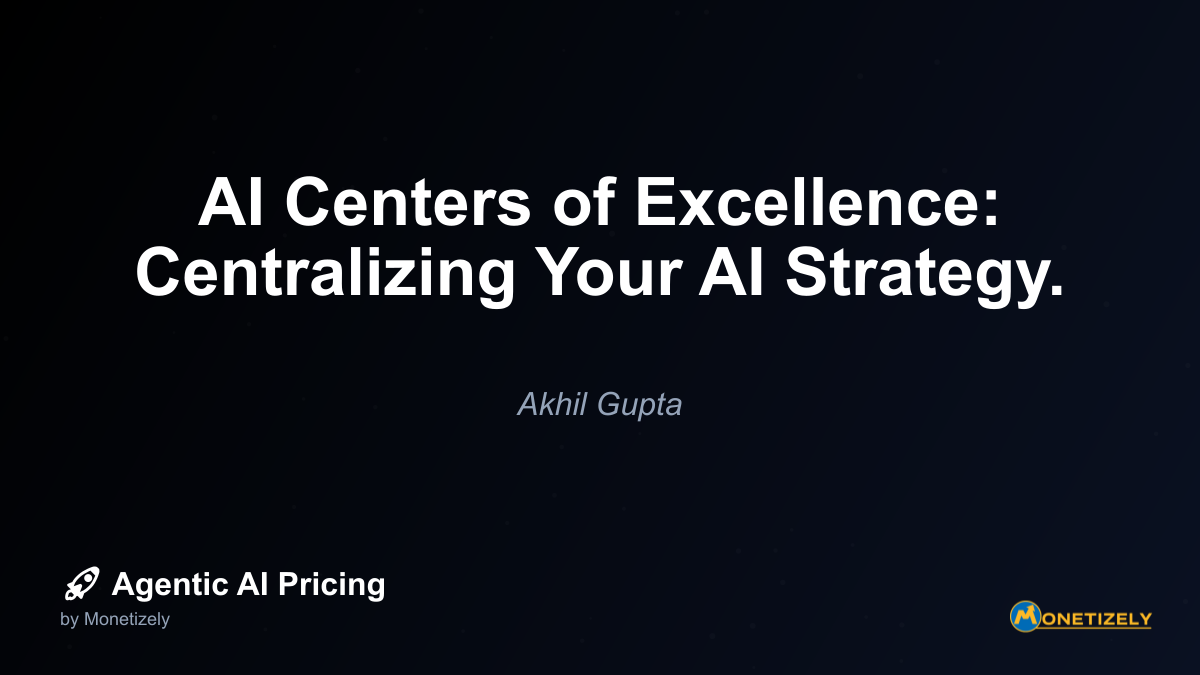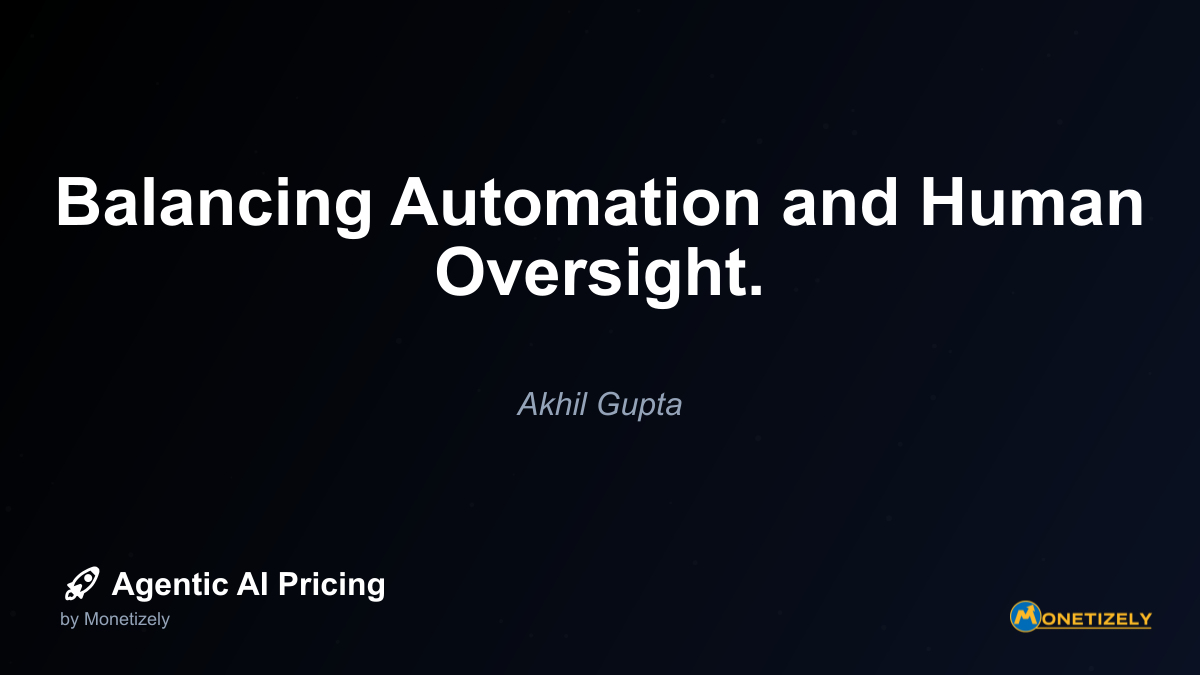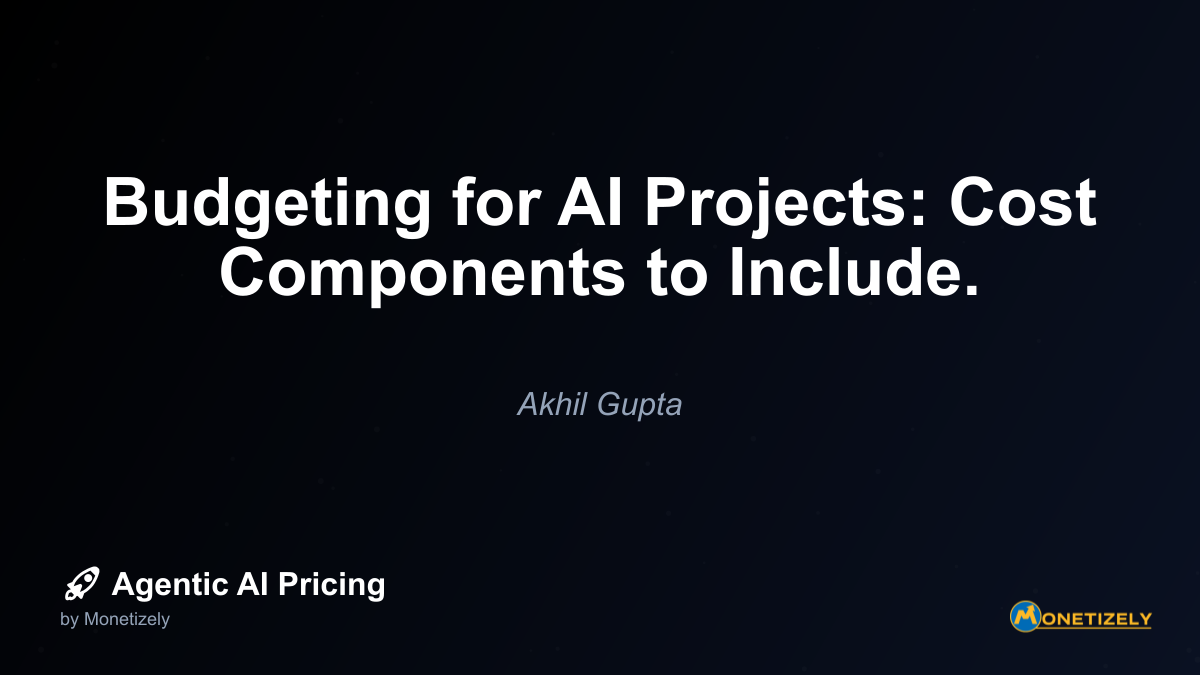· Ajit Ghuman · Implementation Strategies · 13 min read
Change Management: Introducing AI Agents into Your Organization.
AI and SaaS Pricing Masterclass
Learn the art of strategic pricing directly from industry experts. Our comprehensive course provides frameworks and methodologies for optimizing your pricing strategy in the evolving AI landscape. Earn a professional certification that can be imported directly to your LinkedIn profile.

The human element of AI adoption represents one of the most critical yet often underestimated components of successful implementation. While organizations frequently focus on the technical aspects of AI agents, the psychological and sociological dimensions of this transformation demand equal, if not greater, attention. Effective change management strategies can mean the difference between a thriving AI-enabled organization and a failed implementation that wastes resources and damages morale.
Understanding the Human Response to AI Agents
The introduction of AI agents into an organization triggers complex human responses that extend beyond simple resistance to change. Research indicates that employees experience a range of emotions, from curiosity and excitement to anxiety and fear. According to a recent study, 70% of change efforts fail, often due to employee resistance, and between 2016-2022, the average employee experienced a rise from 2 to 10 planned enterprise changes yearly, increasing “change fatigue.”
These responses are rooted in several key concerns:
Job security fears: Many employees worry that AI agents will replace their roles or significantly diminish their value to the organization.
Skill relevance anxiety: Workers question whether their current skills will remain valuable in an AI-augmented workplace.
Loss of control: The perception that decision-making authority may shift from humans to algorithms creates discomfort.
Identity disruption: For many professionals, work identity is closely tied to specific tasks that AI may automate.
Learning curve concerns: Employees may worry about their ability to adapt to new technologies and workflows.
Understanding these psychological barriers is the first step toward developing effective change management strategies for AI agent adoption.
Strategic Framework for AI Agent Change Management
Successful AI agent implementation requires a comprehensive change management approach that addresses both technical and human aspects of the transformation. Based on extensive research and case studies, the following framework provides a strategic roadmap for organizations.
1. Establish a Clear Vision and Purpose
Before introducing AI agents, leadership must articulate a compelling vision that answers fundamental questions:
- How will AI agents enhance the organization’s capabilities?
- What specific problems will these technologies solve?
- How will AI agents augment human work rather than replace it?
McKinsey research shows that CEO-led transformation mandates are crucial for success, moving beyond pilots to enterprise-wide scaled adoption. As one change management expert notes, “Without a clear ‘why’ that resonates with employees, even the most sophisticated AI implementation will struggle to gain traction.”
Case Study: IBM effectively integrated AI by focusing on building trust and transparency. They used AI to predict talent gaps and support employees, ensuring alignment with strategic objectives. Their leadership clearly communicated how AI would enhance employee capabilities rather than replace them, resulting in higher adoption rates and less resistance.
2. Assess Organizational Readiness and Impact
Before implementation, conduct a thorough assessment of:
- Current organizational culture and attitudes toward technology
- Existing skills and knowledge gaps
- Workflows that will be affected by AI agents
- Potential resistance points and change champions
This assessment should include stakeholder mapping to identify key influencers, potential resistors, and change advocates across the organization. According to research, organizations that conduct comprehensive readiness assessments are 2.5 times more likely to achieve their AI implementation goals.
3. Develop a Tailored Communication Strategy
Communication is the cornerstone of effective change management. For AI agent adoption, communication strategies should:
- Be transparent about the purpose, timeline, and impact of AI implementation
- Address concerns proactively, particularly around job security
- Highlight success stories and early wins
- Use multiple channels to reach different audiences
- Maintain consistent messaging while tailoring to different stakeholder groups
Communication Framework Example:
| Audience | Key Messages | Channels | Frequency |
|---|---|---|---|
| Executive Leadership | Strategic benefits, ROI, competitive advantage | Executive briefings, strategy sessions | Monthly updates |
| Middle Management | Implementation roadmap, team impact, resource allocation | Management workshops, training sessions | Bi-weekly updates |
| Front-line Employees | Personal benefits, skill development opportunities, support resources | Team meetings, digital platforms, training sessions | Weekly updates |
| IT and Technical Teams | Technical specifications, integration plans, security protocols | Technical briefings, collaboration platforms | Ongoing as needed |
Effective communication strategies emphasize ethical AI use and frame AI adoption as a partnership between employees and technology, highlighting inclusivity and continuous learning.
4. Secure and Leverage Executive Sponsorship
Strong executive sponsorship is critical for successful AI agent adoption. Research indicates that visible and active sponsorship from senior leadership increases the likelihood of change success by up to 70%.
Effective executive sponsorship approaches include:
- Visible, consistent executive advocacy highlighting AI’s strategic importance
- Executives participating in training sessions to demonstrate commitment
- Establishing cross-functional steering committees chaired by senior leaders
- Resourcing change initiatives robustly and empowering managers to lead
- Utilizing executives to communicate transparently about AI impact and governance
As one change management expert noted, “When employees see leadership actively engaged with AI technologies and openly discussing both benefits and challenges, it significantly reduces resistance and anxiety.”
5. Empower Middle Managers as Change Agents
Middle managers serve as the critical bridge between strategic vision and frontline implementation. They are often the most influential factor in employee adoption of new technologies.
Strategies to empower middle managers include:
- Providing comprehensive training on both the technical aspects of AI agents and change management techniques
- Equipping them with tools to monitor and coach employee AI interaction
- Creating forums for managers to share challenges and successes
- Developing clear escalation paths for issues that arise during implementation
- Recognizing and rewarding effective change leadership
Training Program Example: The “Stress-Free Change Management for Generative AI” course offers a 9-step framework tailored for busy managers to lead AI transformations, teaching them to overcome resistance, communicate vision, and build AI-first cultures. It includes practical, ready-to-use resources like AI communication plans and governance models to support managers in real-time implementation.
6. Develop Comprehensive Training and Support Programs
Effective training is essential for successful AI agent adoption. Training programs should:
- Be tailored to different roles and skill levels
- Focus on both technical skills and adaptive capabilities
- Include hands-on practice with AI agents in realistic scenarios
- Provide ongoing support beyond initial implementation
- Measure and track skill development progress
Successful Training Approaches:
Personalized Learning Paths: AI-powered platforms like Beam AI provide continuous feedback and automate assessments to keep training relevant and adaptive to individual employee needs.
Skill Gap Analysis: Targeted upskilling based on identified gaps between current capabilities and required skills for AI collaboration.
Peer Learning Networks: Creating communities of practice where employees can share experiences and solutions.
Just-in-Time Learning: Providing resources at the point of need rather than in extensive pre-implementation sessions.
Simulation and Scenario-Based Training: Allowing employees to practice with AI agents in safe, controlled environments before full implementation.
7. Address Industry-Specific Challenges
Different industries face unique challenges when implementing AI agents, requiring tailored approaches:
Healthcare:
- Challenges: Patient data privacy concerns, clinical staff resistance, regulatory compliance
- Solutions: Early clinician involvement, comprehensive privacy governance, demonstrating AI as an augmentation to care providers
- Example: Mayo Clinic’s implementation of AI diagnostic tools involved extensive clinician input and clear protocols for when AI recommendations should be followed versus questioned.
Finance:
- Challenges: Trust in AI decision-making, compliance risks, client data security
- Solutions: Transparent AI explainability, robust audit frameworks, continuous upskilling
- Example: Bank of America’s “Erica” virtual assistant was implemented with clear messaging about security protocols and limitations, building trust with both employees and customers.
Manufacturing:
- Challenges: Workforce anxiety about automation, skill gaps, integration with legacy systems
- Solutions: Hands-on AI training, phased rollout, collaboration with labor representatives
- Example: A major manufacturer modernized legacy systems by deploying AI agent squads supervised by humans, cutting time and effort by more than 50% while maintaining worker engagement by elevating them to supervisory roles.
8. Implement Governance and Ethical Frameworks
Governance frameworks ensure that AI agents are deployed responsibly and ethically, addressing concerns about bias, privacy, and decision-making transparency. Key components include:
- Clear AI policy documents defining acceptable use, transparency, and accountability
- Regular AI risk assessments and bias monitoring
- Defined roles and responsibilities for AI oversight
- Continuous compliance with industry regulations and ethical standards
- Communication plans to keep all employees aware of governance commitments
Case Example: IBM’s AI Ethics Board provides oversight for all AI implementations, ensuring alignment with the company’s ethical principles and providing a clear escalation path for concerns.
9. Create a Culture that Embraces AI-Human Collaboration
Beyond specific implementation strategies, organizations must foster a culture that embraces AI-human collaboration. Key practices include:
- Celebrating and recognizing successful human-AI partnerships
- Encouraging experimentation and learning from failures
- Maintaining open forums for discussing AI concerns and innovations
- Emphasizing the complementary nature of human and AI capabilities
- Demonstrating how AI frees humans for more creative, strategic work
Research indicates that organizations with strong collaborative cultures experience 81% higher AI adoption rates than those with more competitive internal environments.
10. Measure and Monitor Progress
Effective change management requires ongoing measurement and monitoring. Key metrics include:
- Adoption Metrics: Usage rates, feature utilization, user growth
- Performance Metrics: Productivity improvements, error reduction, time savings
- Sentiment Metrics: Employee attitudes, concerns, satisfaction levels
- Business Impact Metrics: ROI, cost savings, new capabilities enabled
Measurement Framework Example:
| Metric Type | Specific Measures | Collection Method | Frequency |
|---|---|---|---|
| Adoption | AI agent usage rates, feature utilization | System analytics | Weekly |
| Performance | Task completion time, error rates, output quality | Performance tracking | Monthly |
| Sentiment | Employee confidence, satisfaction, concerns | Surveys, focus groups | Quarterly |
| Business Impact | Cost savings, revenue impact, customer satisfaction | Financial analysis, customer feedback | Quarterly |
Practical Implementation Strategies
Moving from framework to action requires specific, practical strategies. The following approaches have proven effective across multiple organizations implementing AI agents.
Addressing Resistance Through Behavioral Economics
Behavioral economics offers valuable insights for overcoming resistance to AI agents. Key strategies include:
Framing: Position AI agents as tools that enhance human capabilities rather than replacements for human work.
Loss Aversion: Emphasize what employees stand to lose by not adopting AI (competitive disadvantage, increased workload) rather than only focusing on benefits.
Social Proof: Highlight successful adoption by respected peers and colleagues to normalize AI agent use.
Choice Architecture: Structure implementation to give employees meaningful choices about how they integrate AI into their workflows.
Defaults: Set AI collaboration as the default approach while allowing opt-outs when appropriate.
Demographic-Specific Approaches
Different employee demographics may require tailored change management approaches:
Age Groups:
- Younger employees may be more open to AI but need clarity on career implications
- Older workers may benefit from additional reassurance and tailored learning approaches
- Cross-generational mentoring can bridge gaps and leverage diverse perspectives
Technical vs. Non-Technical Staff:
- Technical staff benefit from detailed AI training and involvement in design/testing
- Non-technical staff need simpler messaging and clear support channels
- Creating mixed teams can help knowledge transfer between different groups
Management Levels:
- Executives need strategic frameworks and competitive intelligence
- Middle managers need practical implementation tools and team management strategies
- Front-line supervisors need specific guidance on day-to-day integration
Cross-Cultural Considerations
For global organizations, cultural differences significantly impact AI agent adoption:
- Western cultures may emphasize individual autonomy and control in AI implementation
- Eastern cultures may focus more on collective benefits and harmony in adoption approaches
- Power distance in hierarchical cultures may require stronger leadership mandates
- Uncertainty avoidance in some cultures may necessitate more detailed planning and assurance
Example: Microsoft tailored its change management approach for AI tools in Japan by emphasizing group harmony and collective improvement, while in the US, the focus was on individual productivity gains and career advancement.
Case Studies: Success and Failure in AI Agent Change Management
Examining real-world examples provides valuable insights into effective change management strategies.
Success Case: H&M’s Virtual Shopping Assistant
H&M implemented an AI-powered virtual shopping assistant to manage customer inquiries across channels. Their change management approach included:
- Clear Goal Definition: Specific objectives for customer service improvement and employee augmentation
- Infrastructure Assessment: Comprehensive evaluation of technical readiness
- Phased Implementation: Gradual rollout with continuous feedback loops
- Extensive Training: Customer service representatives received hands-on training and clear guidelines for when to intervene
- Continuous Refinement: Ongoing improvements based on employee feedback
The result was reduced response times, improved customer satisfaction, and higher employee engagement as representatives shifted to more complex and fulfilling interactions.
Failure Case: A Major Retailer’s Inventory Management AI
A large retailer attempted to implement AI agents for inventory management without adequate change management, resulting in:
- Lack of Clear Communication: Employees received minimal information about the purpose and impact of the AI system
- Insufficient Training: Store managers and staff were unprepared to work with the new technology
- No Feedback Mechanisms: There was no way for employees to report issues or suggest improvements
- Absence of Executive Sponsorship: Leadership was not visibly engaged in the implementation
The result was widespread resistance, underutilization of the system, and eventual abandonment of the initiative at significant cost to the organization.
ROI and Business Case for Effective Change Management
Investing in change management for AI agent adoption delivers measurable returns. Research indicates:
- Organizations with excellent change management are 6x more likely to meet or exceed project objectives
- Effective change management can reduce implementation time by up to 33%
- Projects with strong change management show 15-20% higher ROI than those without
Cost-Benefit Analysis Example:
| Change Management Investment | Potential Returns |
|---|---|
| Training and development programs | Reduced implementation time, higher adoption rates |
| Communication resources and platforms | Lower resistance, faster time to value |
| Leadership engagement activities | Stronger organizational alignment, sustained adoption |
| Governance framework development | Reduced risk, higher trust, better compliance |
As one executive noted, “The cost of effective change management is minimal compared to the cost of failed AI implementation. We’ve found that every dollar spent on change management returns at least five dollars in accelerated benefits realization.”
Industry-Specific Implementation Frameworks
Different industries require tailored approaches to AI agent change management:
Healthcare Implementation Framework
- Clinical Involvement: Engage medical professionals in AI agent selection and implementation
- Patient-Centered Messaging: Frame AI benefits in terms of improved patient outcomes
- Regulatory Compliance: Ensure all AI implementations meet healthcare regulations
- Phased Implementation: Start with non-clinical areas before moving to clinical applications
- Continuous Validation: Regularly verify AI recommendations against clinical expertise
Financial Services Implementation Framework
- Risk Assessment: Evaluate potential risks of AI decision-making in financial contexts
- Compliance Integration: Build regulatory compliance into all AI agent applications
- Client Trust Building: Develop clear messaging about how AI enhances client service
- Advisor Augmentation: Position AI as enhancing advisor capabilities rather than replacing them
- Transparent Governance: Maintain clear oversight of AI recommendations and decisions
Manufacturing Implementation Framework
- Workforce Partnership: Engage labor representatives early in implementation planning
- Skills Transition Planning: Develop clear pathways for workers to move into AI supervision roles
- Safety Integration: Ensure AI agents enhance rather than compromise safety protocols
- Phased Automation: Implement AI in stages with clear communication at each phase
- Performance Measurement: Track productivity and quality improvements to demonstrate value
Communication Templates and Tools
Effective communication is essential for successful AI agent adoption. The following templates provide starting points for key communications.
Executive Announcement Template
Subject: Enhancing Our Capabilities: Our Journey with AI Agents
Dear [Team/Organization],
Today, I'm excited to announce an important strategic initiative that will enhance our capabilities and position us for future success. We are beginning a journey to integrate AI agents into our operations in ways that will augment our team's talents and create new opportunities for growth and innovation.
This initiative aligns with our core values of [relevant values] and our commitment to [strategic goals]. The AI agents we'll be implementing are designed to handle [specific tasks], allowing our team to focus on [higher-value activities].
I want to emphasize that this technology is intended to enhance your work, not replace it. Your expertise, creativity, and judgment remain our most valuable assets. The AI agents will handle routine tasks, analyze data, and provide insights—but you will direct their work and make the crucial decisions that drive our success.
Over the coming [timeframe], you'll receive more information about specific changes, training opportunities, and how you can contribute to this initiative. Your input and feedback will be essential as we move forward together.
I'm committed to making this a positive transformation for our organization and each of you personally. If you have questions or concerns, please don't hesitate to reach out to [contact person/department].
[Signature]
[Executive Name]Manager Briefing Template
Subject: Preparing Your Team for AI Agent Implementation
Dear Managers,
As we prepare to implement AI agents across our organization, your role as a leader and change champion is crucial to our success. This briefing provides key information to help you prepare your team for this transition.
Implementation Timeline:
[Specific dates and milestones]
Your Team's InvolvementCo-Founder & CEO
Ajit is the author of Price To Scale, a top book on SaaS Pricing and is the Founder of Monetizely. Ajit has led and worked in pricing and product marketing at firms like Twilio, Narvar and Medallia. His work has been featured in Forbes and VentureBeat. Ajit regularly consults with software companies from Seed stage to post-IPO on pricing strategy. Ajit is also a highly-rated co-instructor for 'The Art of SaaS Pricing and Monetization' on Maven.
Pricing Strategy Audit
Let our experts analyze your current pricing strategy and identify opportunities for improvement. Our data-driven assessment will help you unlock untapped revenue potential and optimize your AI pricing approach.




